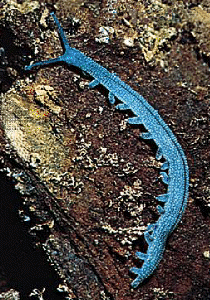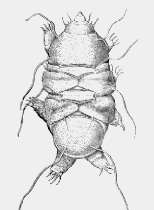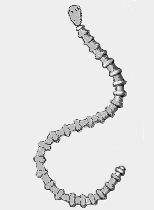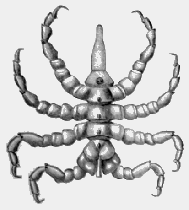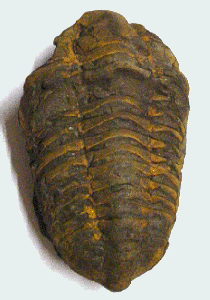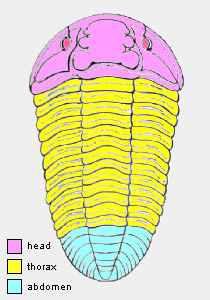
Consulting Entomologist

Tel/Fax: 01275 854224
E-Mail: [email protected]
Site Guide
Site Search
Home Page
Career Page
Insect Files
- Contents
- Bug Index
- The World of Bugs
- Classification of Bugs
- Insect Identification
- Insect Fossils
- Insect Body-parts
- Micro View of Bugs
- Insect Life Cycles
- Insect Defences
- Insects of Nailsea
- Pesticide Safety
- Bibliography
Shortcut to the main groups of insects and other arthropods...
Bug Rhymes & Poems
Links
Shop
Payments (credit/debit card)
Arthropod Oddments |
Class: (various) |
| Is it a crab, a spider or something else? . . . . . . | |
|
Onychophora (Velvet Worms) | |
|
The Onychophora, commonly called velvet worms, form a small group of about 70 known species of caterpillar-like, terrestrial invertebrates confined to the tropical rainforests of Central and South America, Australia, Africa, Asia and a few other regions. They cannot tolerate dry habitats and live in moist places among leaf litter, under stones and fallen logs, or in crevices and galleries in the soil. They avoid light and usually remain well concealed from casual observation. All the velvet worms are predatory, feeding on small invertebrates such as crickets, spiders, and woodlice. They catch and subdue their prey by spitting a quick-hardening slime from projections (called oral papillae) near the mouth. They also squirt slime in self-defence when attacked or disturbed. Onychophorans range in size from about 2-15 cm in length and the body is covered with a thin, dry cuticle that is finely ridged and convoluted, giving a velvety appearance to the surface, hence the common name of the group. Body colouring varies from dark bluish-grey to reddish-brown, usually with a darker median stripe along the back. The head appendages include a pair of antennae and jaws, and the elongate body consists of numerous trunk segments (around 15-45 depending on the species), each bearing a pair of short, thick legs. The legs differ from true arthropod legs by lacking joints, but they do have terminal claws which superficially resemble the leg-claws of true arthropods. The best known velvet worms belong to the genus Peripatus. |
|
|
The anatomy of onychophorans is a mixture of annelid-like and arthropod-like features, and in evolutionary development they are generally considered intermediate between the annelid worms and the arthropods - perhaps descendants of a line that branched off close to the primitive annelid-arthropod stock. There is certainly no doubt that the Onychophora are very ancient, since their fossil remains date back some 520 million years to the Cambrian*. Photo:
Encyclopædia Britannica 2004 Ultimate Reference Suite DVD | |
| <<< TOP | |
|
Tardigrada (Water Bears) | |
|
The Tardigrada, or water bears, are a cosmopolitan group of free-living invertebrates, with about 350 known species. All are minute, more or less translucent animals, generally 1 mm or less in length, and live in various habitats, including damp moss, on flowering plants, in sand, in freshwater, and in the sea. They have a well developed head region and a short body composed of four fused segments. Each body segment has a pair of short, stout, unjointed legs, usually terminated by several sharp claws (in one exceptional genus the legs are two-jointed). Most of the plant-eating tardigrades feed by piercing individual plant cells with their stylets (spear-like structures near the mouth) and then sucking out the cell contents. A few species are predacious carnivores. A remarkable feature of the tardigrades is their ability to withstand extremely low temperatures and desiccation. Under unfavourable conditions, they go into a resistant state of suspended animation. Laboratory studies have shown that specimens kept for eight days in a vacuum and then exposed for several hours to a temperature of -272oC (-458oF) came to life again when they were brought to normal room temperature. Sixty percent of specimens kept for 21 months in liquid-air at a temperature of -190oC (-310oF) also revived. In nature, tardigrades are often dispersed by wind and water while in such resistant states, and by this means they can quickly colonize new habitats. |
|
|
The evolutionary position of the Tardigrada is generally thought to lie somewhere between annelid worms and arthropods, and like the Onychophora described above, they may have survived relatively unchanged from very ancient origins at or near the base of the whole arthropod ancestral tree. | |
| <<< TOP | |
|
Pentastomida (Tongue Worms) | |
|
The Pentastomida, or tongue worms, are a small group of about 70 species of worm-like or fluke-like endoparasites of back-boned animals (vertebrates). They are mostly found in the tropics and subtropics, although those with warm-blooded hosts may also occur in cold or temperate regions. Adult tongue worms are usually whitish in colour and range in size from a few millimetres to about 15 cm in length. The front part of the body (termed the cephalothorax) bears the mouthparts and two pairs of hooks which serve as organs of attachment to the host animal. The rest of the body (termed the abdomen) is either cylindrical in form (as in the Porocephalus species illustrated) or broad and flattened (e.g., Linguatula species), generally with conspicuous segmental rings. The young stages of pentastomids (referred to as larvae) have a rounded body with stylet-like, piercing mouth-parts at the front-end and two pairs of clawed legs further back. Apart from fewer legs, they more or less resemble tardigrades in general body form (see above). The larvae moult several times and eventually loose their limbs as they develop to the adult stage. |
|
|
Adult pentastomids live in the respiratory systems (nasal cavities, lungs, etc.) of carnivorous reptiles, birds and mammals. The flesh-eating animals, which harbour the adult parasites, are called primary hosts. This is because tongue worms have a complex life-cycle involving an intermediate or secondary host, usually a herbivore or omnivorous animal, in which the young stages develop. Eggs are discharged from the primary host, usually through sneezing or coughing. If they fall on grass or other vegetation and then become ingested by a suitable plant-feeding secondary host, the eggs hatch into larvae which burrow through the gut-wall into the neighbouring viscera or body organs of this host, where they come to rest and form dormant cysts. If an infested secondary host is then eaten by a carnivore (the primary host), the encysted larvae escape and migrate to the nasal chambers or lungs of this host, where they moult into adults which attach and anchor themselves by their hooks and mouth-parts to the surface tissues and begin feeding on the blood of the primary host animal. Pentastomid species belonging to the genus Porocephalus are mainly parasitic in snakes and rodents, whilst members of the other main genus of the group, Linguatula, usually parasitize various mammals, including dogs. A few species are of medical interest because they may infest humans. The anatomy of adult pentastomids has been so much modified and altered by parasitic life that their origins and affinities to other invertebrates are rather obscure. However, their larval stages, with clawed limbs, are reminiscent of the Tardigrada and, like this group, they are generally thought to lie somewhere between annelids and arthropods in evolutionary development. Some authorities regard the group as an ancient and specialised off-shoot of the early arachnids. | |
| <<< TOP | |
|
Pycnogonida (Sea Spiders) | |
|
The Pycnogonida, commonly known as sea spiders, are spider-like marine invertebrates that live on the sea-bed. Their body size ranges from a few millimetres in some shallow-water species up to 50 cm in length among deep-water species. Most pycnogonids have four pairs of exceptionally long, thin legs, often six or seven times longer than the body, although in some forms (as in the species of Pycnogonum illustrated) the legs are relatively short and stout. The legs have terminal claws and are attached to a four-segmented trunk or cephalothorax, which forms the main part of the body, with the abdomen behind reduced to a single segment. The mouth lies at the end of an elaborate suctorial appendage (or proboscis) which is often longer and larger than all the rest of the body. Some species also have palp-like appendages attached to the cephalothorax on either side of the proboscis. The first segment of the cephalothorax usually bears four simple eyes, although these are often lacking in the deep-water species. The cuticle of the body and limbs is very hard and strong, generally brownish in colour, and often raised into pronounced bumps and tubercles, particularly along the back. |
|
|
Sea spiders are carnivores and either suck the juices from soft-bodied invertebrates or browse on hydroids and bryozoans (sedentary corals and coral-like animals). Their reproduction is of interest since it involves parental care by the males. Until the hatching of the young, the male carries the egg-mass produced by the female under his cephalothorax, attached to a special pair of appendages, sometimes called the ovigerous legs. The larval or juvenile stages of many species are parasitic in hydroids or molluscs. The long legs of pycnogonids are often injured or lost, but evidently they can repair and regenerate damaged limbs. There are more than 600 described living species of Picnogonida, and at least one fossil species from the Jurassic Period* (about 150-200 million years old). The group has sometimes been affiliated to the arachnids, but the similarities here are fairly tenuous and most modern classifications place the pycnogonids as a distinct Class of the arthropods on the assumption that they probably arose from ancient arthropod stock quite independently, either before or close to the arachnid branch. Several older works note the broad resemblance between juvenile pycnogonids and the nauplius (or planktonic) larvae of some marine crustaceans. Detailed examination of these larval forms, however, indicates that their outward resemblance has little or no phylogenetic significance, other than perhaps lending support to an early, pre-arachnid origin. | |
| <<< TOP | |
|
Trilobita (Trilobites) | |
|
The Trilobita (trilobites) are a group of extinct fossil arthropods, easily recognized by their distinctive three-lobed body shape - a domed central area running length-wise forming one 'lobe', and the areas on either side forming the other two 'lobes' - from which the group gets its name. From front to rear, the body was clearly divided into three regions - the head (or cephalon), followed by the thorax and then the abdomen (or pygidium) - see illustrations. The head was covered by a carapace (or cephalic shield), more or less semicircular in shape, with a pair of compound eyes present in most species. In some forms the rear corners of the cephalic shield were produced backwards to form long spines. The thorax consisted of several freely articulating segments (up to about 25 in some species), which evidently allowed the animals to curl up, somewhat after the manner of a present-day woodlouse. The abominal segments were similar to those of the thorax, but apparently fused together to form a ridged 'tail'. Although fossil trilobites are often found in abundance and in an excellent state of preservation, it is only in rare examples that anything can be seen of the lower side and appendages. These few specimens indicate that paired appendages, essentially similar to those of most cructaceans, were present on each body segment. The head segments bearing a pair of long, jointed antennae and four pairs of shorter palp-like sensory and feeding appendages associated with the mouthparts. The thoracic and abdominal segments, apart from the very last anal segment, each bearing a pair of jointed legs. Trilobites had a hard external covering (or exoskeleton), probably composed of chitinous and perhaps calcareous material, like that of modern crustaceans and other arthropods. Likewise, the exoskeleton was shed periodically to allow growth - shed trilobite 'skins', or portions of them, are often found as fossils. Most triolobites were relatively small, up to a few centimetres long, but some grew to large size. A species of Paradoxides, which has been found near Boston (USA) in rocks of the Middle Cambrian* (about 520 million years old), grew to more than 45 cm in length and may have weighed as much as 4.5 kg. Trilobites were exclusively marine animals, but with only fossil remains nothing is really known about their habits and life-style. Some forms may have been active predators, whereas others were probably scavengers, and a few may have been plankton-feeders. Fossil evidence indicates that they probably layed eggs which hatched into a larval stage, similar in appearance to the adult but with fewer body segments, these increasing in number at each moult as the animal grew and matured. |
|
|
Trilobites have been found in the oldest known fossil deposits of the Lower Cambrian* (about 540 million years old), where they are represented by numerous species. It is evident from this variety of Cambrian forms that the group, even at that remote period, must already have been very old and of Pre-Cambrian origin. The group were clearly an important part of the Cambrian fauna, and came to dominate the seas during the Ordovician Period* (around 440-500 million years ago). In succeeding geological periods they became less abundant, with a marked decline during the Devonian* (360-410 million years ago) and eventual extinction of the entire group by the end of the Permian* (around 250 million years ago). Nothing is yet known about the Pre-Cambrian ancestors of the trilobites, and hence there is no direct evidence of the likely origin of the group. A fossil organism called Spriggina, which is known from Pre-Cambrian shallow-water marine deposits in Australia, may be ancestral to the trilobites, as well as to other arthropods, but this is by no means certain. The trilobites show some resemblance to certain groups of living crustaceans, suggesting some ancestral connection, but in many respects their anatomical features appear to be more primitive than any other known living or extinct arthropods, at least amongst those belonging to the major Classes - the Crustacea, Myriapoda, Arachnida and Insecta. In this respect, a trilobite-like animal is perhaps the closest we can come to picturing the ancestral form that gave rise to all the modern arthropods, and of course the trilobites themselves. | |
| *See the Insect Fossils Page for the main Geological Periods of Earth History |
 (classification of arthropods) |
| <<< TOP | (use the back button on your web browser to return to the previous page) | TOP >>> |
